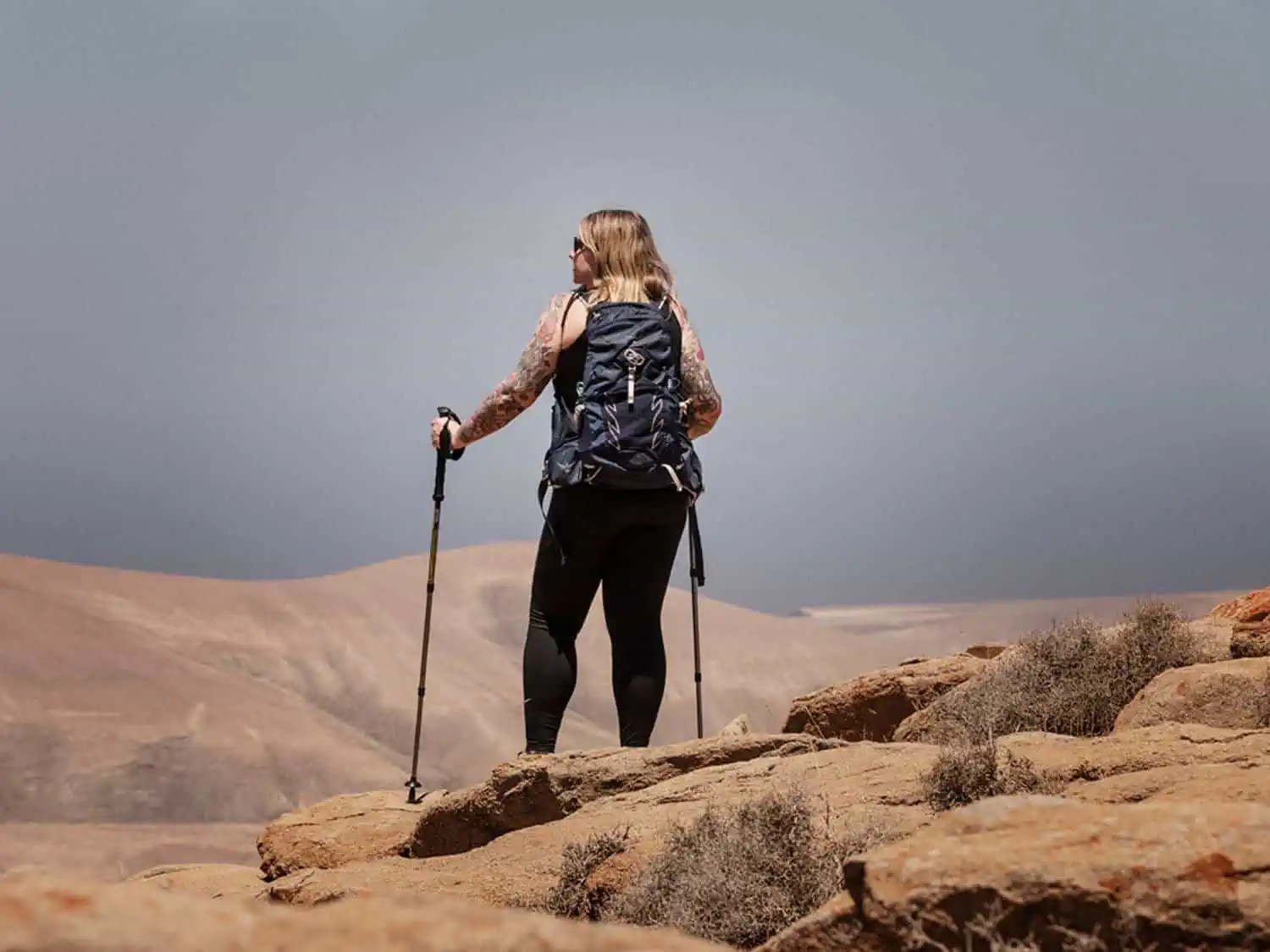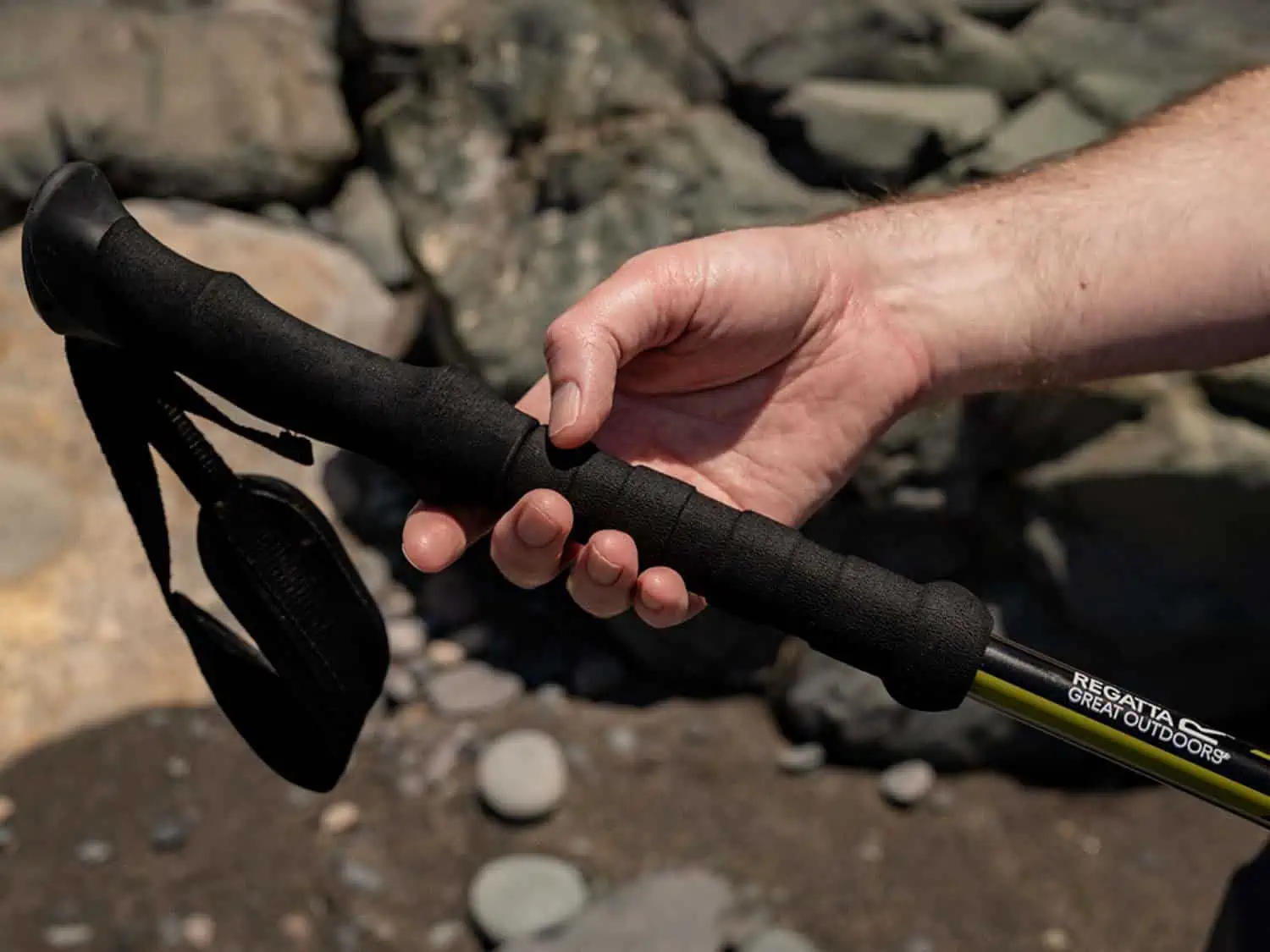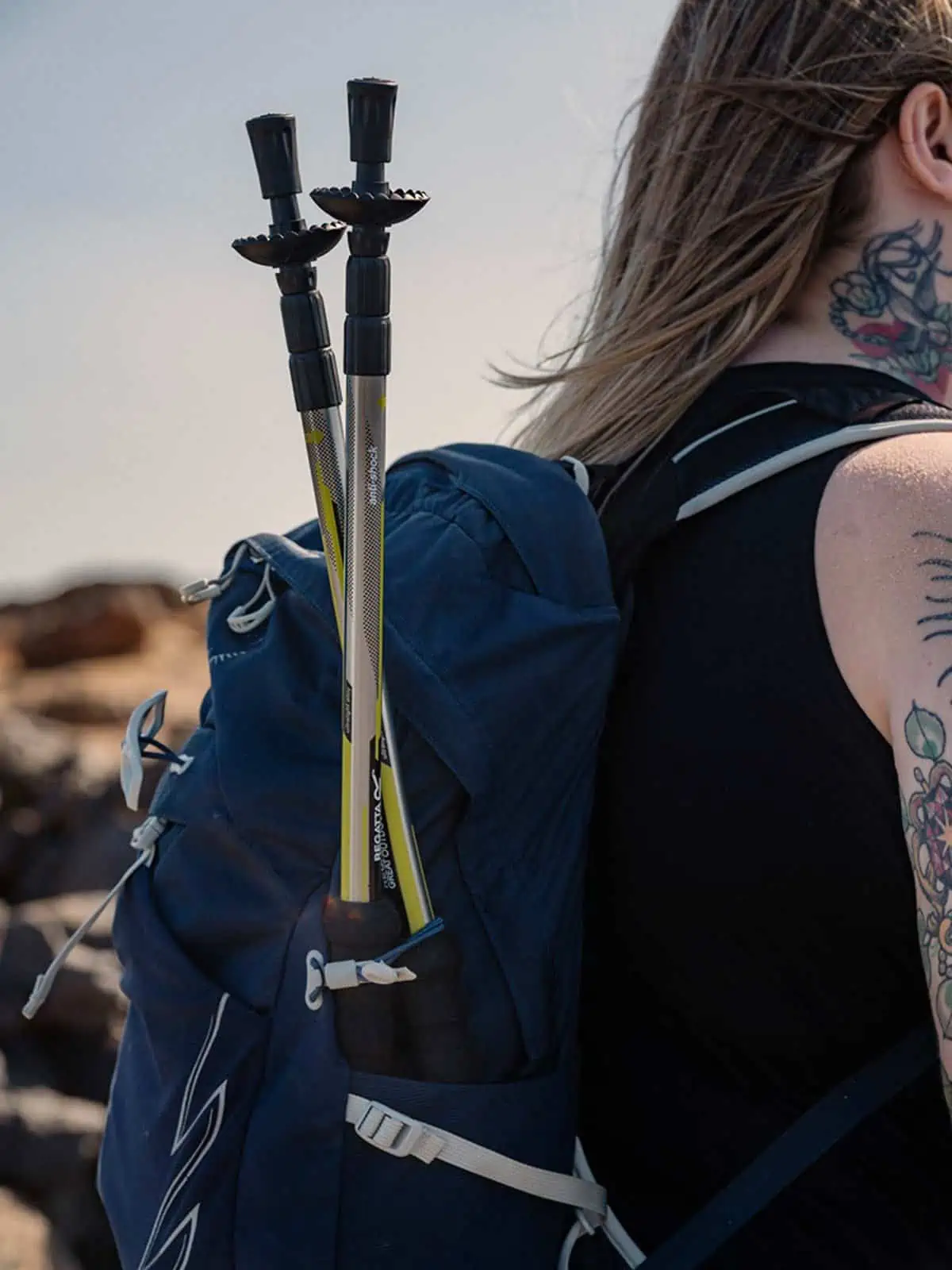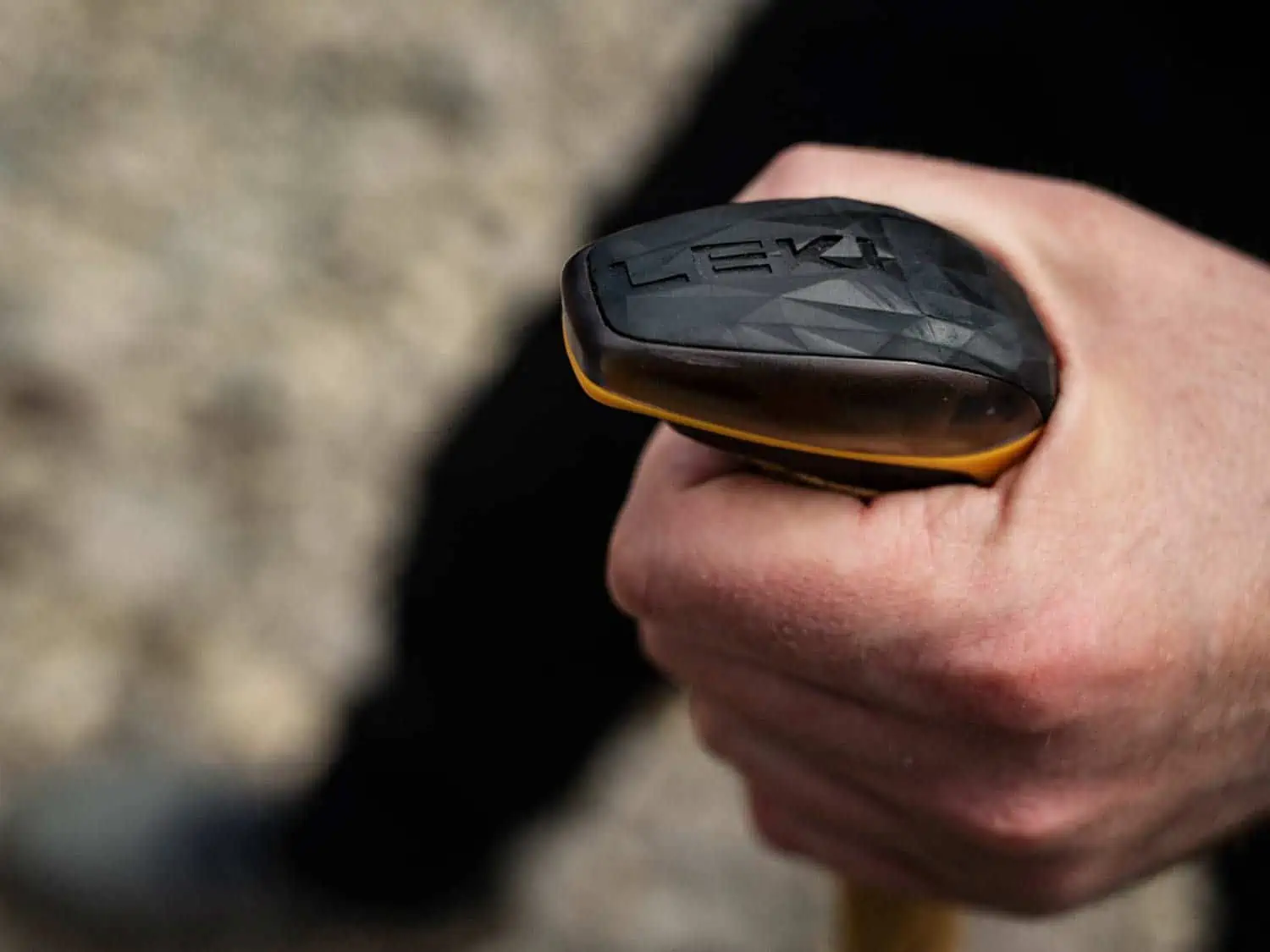We’ve put hiking poles through their paces in as many environments as you can think of, from extreme cold temperatures and deep snow, boulder fields with sharp and loose rocks, muddy hills, sandy deserts and everything in-between to help us put together a comprehensive guide on Trekking Poles. So here is how we tested the trekking poles in our reviews to make our recommendations to you.
Editor’s note: This article is part of our series to the finding the right trekking poles for your hikes, be sure to check out the rest of this guide for our top buying tips:
Table of Contents
ToggleTesting metrics
There was a lot to consider when testing out the different hiking poles in our reviews, from packed size to comfortable grip, shock absorption and whether the materials used would likely stand the test of time or not. Whilst outwardly you might not think there is a lot in it between different trekking poles on the market, there is actually quite a difference, from the comfort you’ll feel using the poles, to the packed size and pole adjustment mechanisms.
Comfort
When making our recommendations, we have looked at the comfort level of the product for the price point it’s offered at. On first glance, it can actually seem like there isn’t much in it when it comes to the comfort you’ll get from a hiking or trekking pole, but actually, the ergonomics of the pole can make quite a difference. For example, we found that the Leki Cressida FX Carbon AS and the Leki Makalu FX Carbon AS made for a particular sense of comfort, especially after long hikes. We put this generally down to the fact that they are both carbon fibre as opposed to aluminium which is known for its shock absorption qualities. Typically, we found less wrist tightness was experienced following the use of these poles as opposed to the other aluminium offerings in our reviews. However, this was marginal.
All the materials of a trekking pole play into the sense of comfort – especially when used over a period of hours, for a longer time or particularly on a hot day. So, we were looking to test how the various hiking poles felt in different situations in order to make our recommendations. The more expensive trekking poles we’ve recommended in our reviews are usually so because the materials used are of a higher specification (as is often the case with outdoor gear). Admittedly, we did notice a difference in how the Leki Makalu FX Carbon AS felt to hold versus, say, the Regatta Ultralite hiking poles. Over time, the Regatta Ultralite hiking poles led to slightly more sweaty palms, whereas the Leki Makalu FX Carbon AS seemed more wicking and absorbent.
There’s also another point to be made when it comes to the comfort of a trekking pole – you’ll see that a lot of the trekking poles out there offer either a ‘men’s’ or a ‘women’s specific pole. The only real difference here is the lengths the hiking poles are offered in and typically the ‘women’s’ specific hiking poles will be offered in shorter lengths. Unless you’re very petite, you would have no problem with a pole that is labelled ‘men’s’. So don’t let this make your decision for you unless the shortest extended height of the pole is a deal breaker. For example, the Leki Makalu FX Carbon AS is basically the same pole as the Leki Cressida FX Carbon AS. The Cressida is simply the ‘women’s’ version and is a different colour and a bit shorter. However, whilst both poles have the same recommended retail price, the Makalu can often be bought at retail for noticeably less than the Cressida. There is sometimes a big difference there in terms of price just for the ‘women’s’ specific model and unless you especially need the shorter length these models offer (or are really taken by the alternative colour way!), then we don’t think this difference is worth paying!
Weight
In terms of weight, we believe that the actual weight of the pole doesn’t generally make a huge difference to how the hiking pole performs on the trail. It’s fairly different in our opinion to the idea of how weight distribution comes into play with hiking shoes, for example. So, when looking at weight, we were really thinking about how heavy the poles we tested would feel when packed away and not used, with particular attention to how this feels on longer hikes over multiple days. If you’re an ultralight backpacker, you might find that you want to opt for a hiking pole that is that bit lighter but gets the balance with ease of use – for example, if you need to tighten the poles on the trail, some of the Black Diamond hiking poles in our reviews need a screwdriver to do so. The Leki Makalu FX Carbon AS is much easier to look after on the trail, and for its 534g/1lb 3oz, is worth the weight. That said, you shouldn’t be expecting to need to adjust very often and this really is picking points here. Really, it’s about thinking around what you usually take with you on your hikes and whether weight is the most important thing whilst the poles are packed down.
When making our recommendations, we also considered how heavy the various hiking poles would be when transporting them in hold on a flight as it’s extremely unlikely you’d be able to take your trekking poles with you in hand luggage. When flying, every gram you carry has to mean something, especially with hefty baggage fees! If you’re someone who really benefits from trekking poles and you fly to a lot of the destinations you hike, you want to know that your hiking poles aren’t going to be taking up unnecessary weight amongst the other items you need to bring with you. Poles like TheFitLife Carbon Fibre Trekking Poles, weighing in at 400g/14oz and the Black Diamond Distance Carbon FLZ Hiking Poles are some of the lightest options in our reviews.
Related content: Can you take hiking sticks or poles on a plane? Find out with our guide.
Shaft Materials
Does the shaft material really make a difference to the hiking poles? Well, it can do. When we were making our recommendations, we didn’t just allow ourselves to fall into the carbon fibre trap, because whilst hiking poles made with carbon fibre are technically more shock absorbent, they can also be more brittle and potentially have a limited range in much colder temperatures.
When testing how the shaft materials of the trekking poles we’ve recommended performed, we looked at how this contributed toward the comfort factor too – from hard, alpine rocks to softer hills, sand and anything in-between. Interestingly, the carbon fibre hiking poles in our reviews were not always lighter than the aluminium poles, and in fact, the Black Diamond Trail Back Poles rival some of the more expensive carbon fibre poles in this regard.
Packed Size
Testing the packed size of hiking poles is a fairly individual thing, as it really depends on how much you want to use your hiking poles and in what circumstances you want to use them. For example, the telescopic hiking poles we’ve reviewed tend to have a larger, or lengthier packed size than the foldable hiking poles in our reviews. If you’re someone who tends to go hiking where you need to spend time on public transport first, you might find a folding version a better variant. If you know you’ll be going through low hanging rocks or other areas where you might need to duck down on the trail, the folding poles may well be a good option for you also. However, if your hiking poles are going to be something you’re using from the start, or the length they ‘stick out’ of your bag isn’t so much an issue then the telescopic trekking pole options may be a good fit for you. When making our recommendations, we really thought about how cumbersome attaching the different hiking poles to your backpack would be, how it feels over time and if you are likely to encounter any difficulties here. Generally, we found we preferred the folding hiking poles for this function, as they can very easily be stored away in the side pouch of a day pack, creating a streamline feel (and not getting in the way). Our favourite foldable hiking poles were Leki Makalu FX Carbon AS, Leki Cressida FX Carbon AS, Trekology TREK-Z Walking Poles for a cheaper option and the Black Diamond Distance Carbon FLZ Hiking Poles.
Pole Adjustment Mechanism
We took into considering how easy, or not, the trekking poles were to adjust and how this fairs when you’re outdoors. One thing we’ve found with trekking poles when adjusting them, is that if your fingers aren’t in the right place, you can trap them and get a nasty pinch! This isn’t really something you want to have happening when you’re on a long hike and perhaps go between using and putting away the trekking poles. We also looked at how easy the trekking poles were to get the hang of without having to watch any instructional videos. The first time we opened the Leki Makalu FX Carbon AS, we were a little confused by the flip lock fasteners and release control, but it didn’t take long before we had this understood. We typically rated products higher than had an easier sense of use – we really don’t believe that setting a hiking pole up needs to be a big production! Especially in colder temperatures or storms where you will want to keep your hands covered as much as possible.
We also considered how the difference between flip locks and twist locks affected the ease of use on the trail. We actually found that some of the hiking pole flip lock screws could either become too tight or too loose over time, and would need to be readjusted. Whereas, the twist lock hiking poles, much like you see on many photography tripods, seemed to hold their grip really well. However, if tightened too much, and used in very cold conditions, the twist lock mechanisms can become harder to open, or particularly so when wearing thick gloves.
Basket Size
Most hiking and trekking poles in our reviews come with a ‘standard’ size basket – which is the small plastic filter that sits near the bottom of the hiking pole where the tip touches the ground. These are generally there to provide a surface to stop the hiking pole sinking too far into the ground, which can be a problem with hiking poles when using them on very rocky paths – where surfaces are made up of large rocks with spaces in-between. This can actually cause your hiking pole, when used without baskets to get stuck and you can end up spending time every few minutes trying to release your poles from the ground. However, the baskets that come with hiking poles aren’t actually all the same size, so we tested how these faired on the various kind of trails where hiking pole sinkage would be a problem. Generally, we found there wasn’t a lot in it, with all the models we tested not giving any problems.
Another area we rated on when it came to basket size was if the manufacturer offers extra parts for your hiking poles. For example, if you plan to use your hiking poles in winter through deep snow, you’ll need to get hold of snow baskets. These basically have a larger surface area than the standard trekking pole baskets so prevent the pole from sinking into the snow, much like how a snowshoe works. We were unable to find if some of the cheaper poles in our reviews offered the option to purchase ‘add-ons’ like snow baskets, but this was something that was easily purchasable with the Leki poles we’ve reviewed, as well as the Black Diamond trekking poles.
Grip Ergonomics and Material
When looking at grip ergonomics and materials for the trekking poles in our reviews, we were considering how the poles felt to hold over a period of time, in various different settings (in fact, we have pretty much tested in all conditions you could expect to encounter). As mentioned earlier, the grip ergonomics of the hiking pole you buy can play into the comfort level you’ll experience, and how the muscles in your hands and arms will feel after the event. We found that some of the cheaper poles in our reviews did feel that bit sweatier after a long day hiking in the summer or in a hot climate, but poles such as the Leki Makalu FX Carbon AS, Leki Cressida FX Carbon AS, Leki Sherpa, Black Diamond Distance Carbon FLZ Hiking Poles and the Black Diamond Trail Ergo Cork Walking Poles all performed very well in this regard. Does the high density foam perform any better or worse than the cork specific poles offered with the Black Diamond Trail Ergo Cork Walking Poles or Black Diamond Alpine Carbon Cork? We’re not sure, we think this makes a very marginal difference.
Leki make a big thing out of their Aergon Air technology when it comes to shock absorption and cushioning on the grip material and handles of their poles, and this was something we considered when looking at trekking poles from other brands in comparison. If you have problems with your wrists, for example, this can actually be incredibly helpful and can mean that you’re not lessening the load from your legs and knees into your wrists instead. Perhaps the grip ergonomics of some of the other models are just as good as the Leki hiking poles and they’re just not making a big deal about it, but we did find that the comfort we experienced with Leki’s products was certainly on the top end.
Price
We looked at all of the features on some of the more expensive poles versus some of the cheaper poles and how that reflects on their longevity. We typically found that the more expensive poles had a variety of features, such as cushioning for shock absorption and comfort, lighter weight, smaller packed size, better fasteners and construction etc. Whilst the more expensive trekking poles in our roundup, such as the Leki Makalu FX Carbon AS, Leki Cressida FX Carbon AS, Leki Sherpa and Black Diamond Distance Carbon FLZ Hiking Poles did admittedly perform some of the best, we didn’t want to just get star struck with those names only. They are quite an investment, and if you’re wanting to try using trekking poles for the first time and aren’t sure whether they’re something you’ll use all the time, it could be hard to justify the price of these. So, we tried to judge if the price to spec ratio really was worth it. Our opinion is that yes, the price points that all of the above trekking poles we’ve mentioned are offered at are worth it if you plan on using your poles quite a lot. However, the Regatta Ultralite hiking poles, TheFitLife Carbon Fiber Trekking Poles and the Trekology TREK-Z Walking Poles all present great options if you’re on more of a budget, want to try trekking poles out or simply don’t want to spend as much. We can’t guarantee that these poles will last as long (for example, we’ve been using the Leki Sherpa for years at this point with no indication of wear and tear whereas some of the cheaper options we’ve tried over the years have struggled a little as time has gone by. If you’re planning to use trekking poles a lot, making an investment in a more expensive pair could save you money down the line.
Disclaimer: This article contains Affiliate Links. You won’t pay any more for buying through these links, but we may receive a commission from any purchases made through them. As an Amazon Associate, I earn from qualifying purchases. If you choose to support us by buying through our links, we thank you as it helps us to continue providing the resources we do to help you enjoy the outdoors more!




